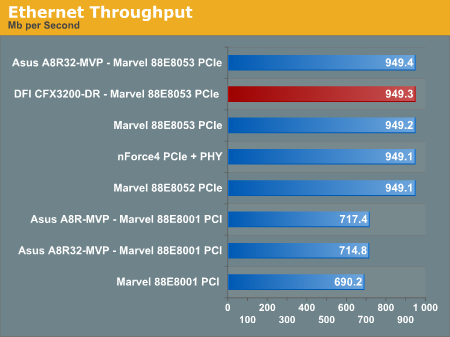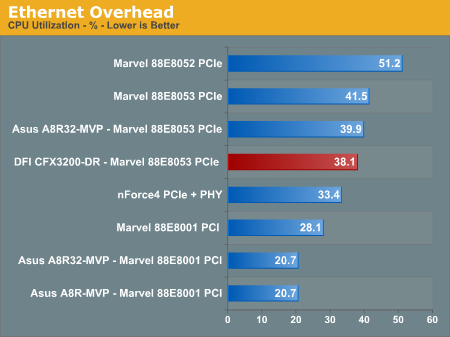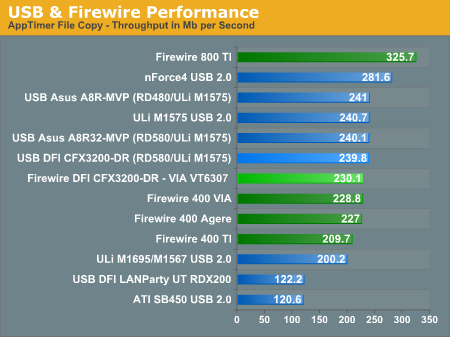DFI CFX3200-DR: ATI RD580 Tweak Attack
by Wesley Fink on May 8, 2006 12:05 AM EST- Posted in
- Motherboards
Network
The Windows 2000 Driver Development Kit (DDK) includes a useful LAN testing utility called NTttcp. We used the NTttcp tool to test Ethernet throughput and the CPU utilization of the various Ethernet controllers used on the AMD motherboards.We set up one machine as the server; in this case, an Intel box with an Intel CSA Gigabit LAN connection. Intel CSA has a reputation for providing fast throughput and this seemed a reasonable choice to serve our Gigabit LAN clients. At the server side, we used the following Command Line as suggested by the VIA whitepaper on LAN testing:
Ntttcps -m 4,0,‹client IP› -a 4 -l 256000 -n 30000
On the client side (the motherboard under test), we used the following Command Line:Ntttcpr -m 4,0,‹server IP› -a 4 -l 256000 -n 30000
At the conclusion of the test, we captured the throughput and CPU utilization figures from the client screen.

As you can clearly see the PCIe Gigabit LAN on the DFI is capable of about 35% faster speed than the performance we have measured with PCI Gigabit LAN used on some competing motherboards. DFI provides a pair of Marvell PCIe Gigabit controllers which should satisfy most end users. All of the on-board PCIe Ethernet controllers seem to exhibit high CPU utilization, but you should keep in mind that the CPU usage we measure is an extremely artificial number which measures the worst case of a continuous 1Gb transmission. With broad-band connections needing less than 100Mb Ethernet, the real-world CPU usage will be much lower than these test results.
USB and Firewire Performance
USB has been a problem area for the ATI SB450 chipset, but it has not been a major issue with the ULi M1575 Southbridge. To test performance of USB and Firewire on the DFI CFX3200-DR we ran our standard USB throughput test using an external USB hard drive. For Firewire tests an external Firewire 400 or 800 hard disk is used for testing. Our test method uses a RAM disk as our "server" since memory removes almost all overhead from the serving end. We also turn off disk caching on the USB and Firewire side by setting up the drives for "quick disconnect". Our results are then consistent over many test runs.We use just 1GB of fast 2-2-2 system memory, set up as a 450MB RAM disk and 550MB of system memory. Our stock file is the SPECviewPerf 8.01 install file which is 432,533,504 bytes (412.4961MB). After copying this file to our RAM disk, we measure the time for writing from the RAM disk to our external USB 2.0 or Firewire 400 or Firewire 800 drive using a Windows timing program written for AnandTech by Jason Clark. The copy times in seconds are then converted into Megabits per second (Mb) to provide a convenient means of comparing throughput. Higher Rates therefore mean better performance. Blue bars represent USB 2.0 performance, while green bars represent Firewire.

The DFI CFX3200-DR performed virtually the same in USB tests as we have measured in other recent tests of the ULi M1575. While USB performance is a bit slower than NVIDIA, it is definitely competitive with the NVIDIA results, with throughput about double the ATI SB450. This is a big improvement and the reason ASUS, ECS, MSI, Abit, and DFI are using ULi M1575 instead. This will likely change with the introduction of the updated ATI SB600, which is expected with the launch of ATI chipset motherboards for AM2.
DFI chose the excellent VIA VT6307 to power the IEEE1394 ports on the CFX3200-DR. The VIA has been tested as fastest Firewire 400 in past results - running neck and neck with the Agere Firewire chip. Performance is where we would expect for the VIA Firewire chip.










25 Comments
View All Comments
Stele - Wednesday, May 10, 2006 - link
IMHO the main disadvantage of using the Sil3114 instead of a newer SATA controller like the 3132 is not so much the 1.5Gbps transfer rate, but the fact that it's PCI-based and hence badly bottlenecked once you fill all four channels. 1.5Gbps is a theoretical maximum and HDDs today are nowhere near that limit - in fact we left ATA-133 without even breaking the ATA-100 limit. Since each SATA HDD gets a dedicated 1.5Gbps channel, arrays won't saturate the SATA interface either - rather, they would saturate the slow PCI interface as previously mentioned. Furthermore, the other significant feature of SATA II - NCQ - is of virtually zero relevance to most users, unless one is using the board in a corporate server; not impossible, but not likely either. Therefore, to harp on a figure that has generally been more a marketing tool (as was ATA-133) than a real necessity says little of the real issues at hand.In return, using the Sil3114 means using a tried and tested product whose characteristics are very well known by now. Board engineers would know how best to design around it - what special requirements (signal integrity, trace lengths, coupling etc), if any, need to be factored in, how the controller performs and behaves and so on. Furthermore, the 3114 provides 4 SATA ports for maximum expansion capability - there is no 4-port version of the 3132 as you alluded to in the review - not yet anyway. You may well be right about having a truckload of 3114s to get rid off, so that's likely a factor too. Perhaps when the 3132 gains a 4-port counterpart (and DFI finishes off 3114 inventory) then we may see newer stuff to come. :)
On another side note, yes there would probably be many people who would appreciate the insane options in BIOS, but I do agree that they should make the UI more user-friendly, e.g. by having Automatic as a choice and/or by placing advanced options in sub-menus to distinguish them from the main options. That would satisfy enthusiasts of all levels, from the mad hatters down to the ones who are just starting out. :)
Generally a review well done! :)
Stele - Wednesday, May 10, 2006 - link
Perhaps that statement should be clarified/qualified a little - there is no 4-port version of the 3132 (i.e. PCIe + SATA II + 3.0Gbps) in a single controller IC. The 3132 supports, and hence is expected to be used with, SATA port multipliers - primarily the SII 3726, which can support up to 5 drives. In future, DFI could use a 3132 with one SATA channel routed to an external connector (as in the Asus A8N32-SLI) while the other channel could be connected to a 3726 to provide an additional 4 or even 5 internal HDD channels.
However, this would create two problems - the need for another IC (the board is already very cramped as it is!) and, as already discussed, the need to gain sufficient experience with the new ICs in the lab before they can be confidently implemented and designed around. Cost and time-to-market factors may also have played a role in DFI's choice.
proamerica - Monday, May 8, 2006 - link
This is a poor quality review. The reviewer complains too much about variables that actually improve performance when handled by the right person. The overclocking potential of this board is beyond all other 939 boards I have owned, including the A8R32-MVP... People all over the place are reporting the highest overclocks ever achieved for memory and CPUs. You have to know what you are doing I'm afraid, and yes it requires using all the settings in the BIOS. That is the caveat of buying this board, its hard to use, and it takes time to figure it out, but once you do its worth it. I stably OC'ed my X2 3800 to 2940Mhz, and I currently run it 24/7 at 2700Mhz. Is 2940Mhz the highest OC I have ever gotten with this processor? Yes, stably, by far the highest. One of the greatest aspects of this board is that it will overclock really high but it doesn't take a lot of voltage to get things stable.Why does the review say: "but this DFI does make us wonder how many end users will actually devote the time to master 32 levels of drive strength, and DQS skew levels of +/- 0 to 255 in 511 levels." Lets see, an extremely expensive motherboard from a company known for making the most tweakable boards around... And you wonder if end-users are going to bother? Yeah they're going to bother. If they don't, they should have purchased something else.
Bottom line, this board beats the A8R32-MVP hands down, its just harder to use than the Asus.
Wesley Fink - Tuesday, May 9, 2006 - link
The review pointed out what you clearly found. It's a difficult board to master, but the options and performance can be outstanding. Some want to take the time to master it, others would prefer a board that is easier to overclock. The real poiunt is the DFI CFX3200 still needs work. The BIOS does NOT need to be so difficult to master, and it wouldn't be if more intelligent choices were made for auto settings.The CFX3200 is not a bad board, it is just a very difficult board to use and master - even for an experienced enthusiast.
Zoomer - Wednesday, May 10, 2006 - link
As mentioned by someone else, the auto (default) settings are nicely choosen - for BH5 memory.Perhaps it would be wise to point that out somewhere, or provide an option of memory: BH5/Normal/Valueram/Manual
ozzimark - Monday, May 8, 2006 - link
"Running four double-sided 512MB or 1GB DIMMs is much more demanding than running two DS DIMMs, and like almost every board we have tested the Command Rate needed to drop to 2T with 4 DS DIMMs."using a high dram drive strength should allow for stable opteration at 1T with 4 double rank sticks in.. :)
bigtoe36 - Monday, May 8, 2006 - link
From the Tweak guide on the bleedinedge forum."Max async latency - options 7 thru 10 are all you should need, 7 for agressive tight timings 10 for high fsb overclocks. This option HAS TO BE SET MANUALLY
Read Preamble - 4.5 thru 6 is all you need worry about, 4.5 for BH5 etc and 6 for high fsb overclocks. i usually use 5.5 and 6. Again HAS TO BE SET MANUALLY"
http://www.bleedinedge.com/forum/showthread.php?t=...">http://www.bleedinedge.com/forum/showthread.php?t=... for the full guide.
Wesley you have the options posted on page 4 the wrong way round, its easy to do as I often get them confused.
Tony
ozzimark - Monday, May 8, 2006 - link
with dfi boards, it's long been my experience that manually setting MAL/RP is a VERY BAD thing.bigtoe36 - Monday, May 8, 2006 - link
Normally that would be the case but DFI were setting 4.5 and 5 as hidden defaults. Now if you are running Bh5 you will have no problems, but most everything else would have issues.Thats why i quoted in my guide and on MANY forums you have to set these manually to get the best from the board.
mbhame - Monday, May 8, 2006 - link
Where's the USB/Firewire CPU Utilization and I/O? Where's IDE performance?Throughput is not indicative of real-world performance for any user I know.